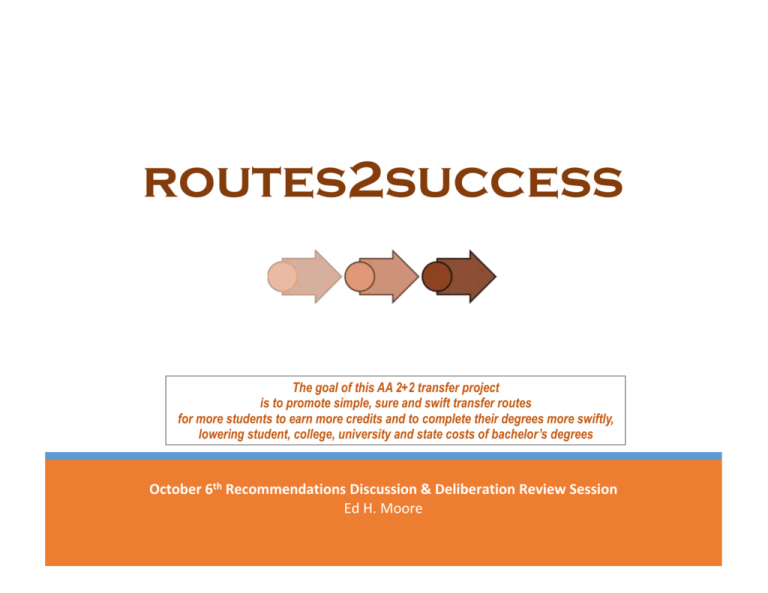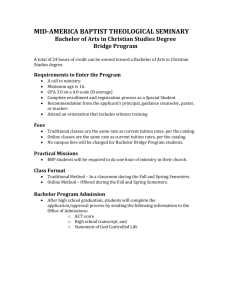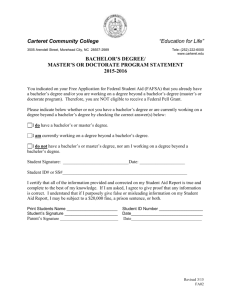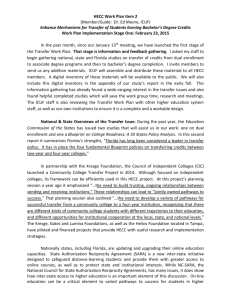Routes2Success Review - Higher Education Coordinating Council
advertisement

routes2success The goal of this AA 2+2 transfer project is to promote simple, sure and swift transfer routes for more students to earn more credits and to complete their degrees more swiftly, lowering student, college, university and state costs of bachelor’s degrees October 6th Recommendations Discussion & Deliberation Review Session Ed H. Moore Counselors Rec 1 - Page 5 The Legislature should: A) Develop a professional development program & network for school, college, university & one-stop center counselors; B) Encourage teachers to earn CEUs in counseling; and C) Require co-counseling for HS students in HS/college credit courses until counseling training upgrades are developed Recommended Legislative Coordination Actions Dual Enrollment Rec 3 - Page 11 A) The Articulation Coordinating Committee (ACC) should: A) Review high school college credit courses to ensure they clearly align with required general education or major requirement; and B) Alert HS students to retain electives for their major’s prerequisites AA Production Rec 9 - Page 16 The Legislature should develop inducements for colleges & universities to have AA students complete their degrees more swiftly, targeting: A) swift AA degree completion; B) AA degree production growth; and C) AA degree production growth of targeted degrees. Rec 5 - Page 13 ICUF & SUS should send FLDOE copies of their dual enrollment agreements and report on credits awarded to enable reporting of the program’s statewide impact Rec 8 - Page 14 The ACC should monitor annual dual enrollment by sector, district, delivery mode and course to determine trends in student participation Rec 10 - Page 16 The Legislature should develop inducements for undergraduates to complete degrees more swiftly Capacity Rec 13 - Page 21 The Legislature should support on-line bachelor’s degree programs as an immediately available route to bachelor’s degrees and also promote collaborations of state, independent and private colleges and universities to coordinated solutions that improve student learning, speed degree completion, and increase on-line degree production statewide. Rec 14 - Page 22 Each sector should update their list of bachelor’s degree by county on TalentNet annually and the Legislature should provide maintenance and sustaining funding support Rec 16 - Page 30 The Legislature should establish a framework to support partnerships that deliver on-site degrees to higher-education/under-served communities Rec 18 - Page 33 The Legislature should launch on-line partnerships for traditional students in higher education under-served communities to earn undergraduate degrees on-line from partnering colleges & universities Rec 20 - Page 35 The Articulation Coordinating Committee should explore the use and efficacy of new transfer student performance measurements focused on lowering credits-to-degree AS Degrees Rec 2 - Page 5 The sectors should promote counselors’ services to the media to better reach students & families Rec 4 - Page 12 The sectors should determine: A) Where HS students with college credits enroll; and B) Do these courses speed time-todegree Rec 11 - Page 17 HECC should encourage highlighting of limitedenrollment degrees and degree pre-requisites on the Florida Virtual Campus, other degree planning websites, sector websites and institutional websites Rec 15 - Page 22 HECC should invite the Florida Virtual Campus to work with the sectors to promote its website to counselors and the sectors should provide FVC with full updates on bachelor’s degrees Rec 6 - Page 13 The non-public sector colleges and universities should consider offering a package of dual enrollment courses to rural school districts Rec 12 - Page 18 HECC should explore, a GPS (Graduation Pathways Service) with FVC and other career planning websites Rec 17 - Page 32 HECC should work with the sectors to track the Commission on Access & Attainment’s Projections, as well as licensing of non-Florida degree holders, and regional – statewide chronic unmet demand for bachelor’s degrees to develop of better profile of high-demand/low-supply bachelor’s degrees Rec 19 - Page 34 A HECC staff group should determine any continuing shortfalls statewide or regionally in the supply of Access and Attainment protected high-demand/lowsupply degrees and report to HECC Recommended Administrative Coordination Actions Rec 7 - Page 14 A Governor’s Fellow should be enlisted to assist in the work of promoting dual enrollment and other acceleration mechanisms to speed time-to-degree and reduce credits-to-degree AS Degrees Rec HECC should convene a team from school district, technical center, stateindependent-private college and university, higher education association, state agency and employer group experts to coordinate the work to upgrade AS degree job and career routes Routes2Success has 20 recommendations focused on counselors, dual enrollment, AA degrees production and bachelor’s degree completion capacity. This recommendations review document chart sorts those recommendations into Recommended Legislative Coordination Action and Recommended Administrative Coordination Actions. There is also a recommendation on continuing work to upgrade AS degrees. A summary of each recommendation and each recommendation follows in this document. For greater detail, refer to the Routes2Success PowerPoint. Summary Overview of Each Routes2Success Recommendation COUNSELING RECOMMENDATIONS UPGRADING SCHOOL TO COLLEGE/UNIVERSITY TO CAREER COUNSELING - Today in Florida, students at universities, colleges, high schools, middle schools and even elementary schools are making earlier career and college credit course decisions. Wrong decisions waste student, school, college and university time and resources. If each degree-seeking student sidesteps just one unneeded course, students, institutions and Florida would save public expenditures. All school, college and university counselors are advising their traditional students on complex and changing higher education requirements, courses, degrees, majors, institutions and careers, as well as handling a multitude of other non-academic assignments. At onestop centers, counselors are advising non-traditional students on higher education routes, as well. Supporting school, college and university counselors (who are the primary expert contact on educational routes), as well as counselors at one-stop centers is a high-priority assignment to help traditional and non-traditional students make the right decisions on right routes to complete their bachelor’s degree. (R2S PowerPoint - Page 5) RECOMMENDATION 1: HECC recommends that the Legislature provide for a professional development program for school, college, university and onestop center counselors that includes on-campus, on-site and on-line courses, modules and videos, as well as a statewide counselors’ network that enables school, college, university and one-stop counselors to consult and advise each other on routes to degrees issues. Teachers could be induced to fulfill continuing education requirements by taking career counseling training and help counselors help students. Until such a professional development program is fully established school districts and postsecondary institutions should enact policies to ensure that both a secondary counselor and a post-secondary counselor are involved in advising students on dual enrollment and other acceleration mechanisms that award both high school and college credits to ensure students pick smart education routes. RECOMMENDATION 2: Each higher education sector should work with higher education media, such as Florida NEXT to highlight and support their institutions’ counselors and the services they provide to students and families. DUAL ENROLLMENT RECOMMENDATIONS DUAL ENROLLMENT COURSES REVIEW - Legislation enacted in 2013 narrowed the General Education Core Curriculum. Those changes take effect this fall. This may mean that the courses included as options in dual enrollment agreements between schools and colleges/universities must be changed. A review of the impact of these forthcoming changes would be timely. Additionally, some dual enrollment courses fulfill AA general course requirements but do not fulfill some limited-enrollment degree or prerequisite requirements. For example, a dual enrollment student who wants to pursue a bachelor’s degree in engineering should take specific AA degree courses and electives. Otherwise they will complete their AA degree and then must complete additional required courses to enter an engineering program, making a 4 or 5 year program one year longer. (R2S PowerPoint - Page 11) RECOMMENDATION 3: The scope of dual enrollment courses (as well as other Acceleration Courses) should be reviewed by the Articulation Coordinating Committee to ensure that course options for students align with the college requirements of students’ intended bachelor’s degree routes, noting courses that fulfill required general education courses and those that would be electives. If a student hasn’t decided a route, they should be alerted that their course selection should focus on basic general education requirements. This will save their AA degree electives until they determine their intended bachelor’s degree major. That will enable them to use these elective options to fulfill prerequisite course requirements, save them time and lower their bachelor’s degree costs. IMPACT ON TIME-TO-DEGREE COMPLETION - The National Student Clearinghouse Research Center’s latest report found more than one-third of first-time-in-college students in 2008 had transferred to a different institution by 2014. Almost half of those who had moved did so more than once. Such transferring students disappear from the federal IPEDS “First-Time-in-College” (FTIC) tracking system, making time-to-degree tracking of these students a complex and confusing challenge and also having effects on retention and graduation statistics. The tracking of dual enrollment credits (as well as the other high school/college credits) is even more challenging. High school students have not applied, been accepted and been enrolled at a college or university as they earn these high school/college credits. Still the assumption is that dual enrollment (as well as the other high school/college credit programs) should speed students to their degree. How can that be determined? (R2S PowerPoint - Page 12) RECOMMENDATION 4: HECC should work with the four higher education sectors (using their existing institutional bachelor’s degree enrollment and degree completion data) to determine: 1) Where are students with dual enrollment and other high school acceleration college credits enrolling in associate or bachelor’s degree programs?; and 2) Do students with dual enrollment and other high school acceleration college credits complete their bachelor’s degrees with fewer total credits than students that do not have such pre-enrollment course credits? PEPC 1997 ACCELERATION MECHANISMS UPDATE Articulation Agreement Guidelines should be used by all sectors and ACC should determine if guidelines are being consistently implemented. (R2S PowerPoint - Page 13) RECOMMENDATION 5: SUS and ICUF institutions should send copies of any dual enrollment agreements they have with school districts to the FLDOE, as well as any summary reports on college credits awarded so that FLDOE can better report on statewide dual enrollment outputs. Delivery of dual enrollment, advanced placement, International Baccalaureate to rural/remote high schools that request such courses should be a priority of distance learning initiatives. (R2S PowerPoint - Page 13) RECOMMENDATION 6: Eligible nonpublic post-secondary institutions should consider offering online dual enrollment courses to rural school districts or rural educational consortiums that are a package of fixed-rate dual enrollment courses to be employed and facilitated in rural school districts. FLDOE should designate staff to assist and coordinate agreements. (R2S PowerPoint - Page 14) RECOMMENDATION 7: A Governor’s Fellow should be enlisted to assist in promoting High School Dual Enrollment and other HS Acceleration Mechanisms, as well as their application toward bachelor’s degree completion requirements. Dual enrollment should be funded as a separate calculation within the Community College Program Fund. (R2S PowerPoint - Page 14) RECOMMENDATION 8: The Articulation Coordinating Committee should monitor annual dual enrollment by sector, district, delivery mode and course to determine trends in student participation. AA RECOMMENDATIONS AA PRODUCTION INDUCEMENTS - Lowering the cost of higher education is a growing imperative. Lessening time spent getting a degree is a strategy that lowers degree costs. Supporting smart student choices and changing student behavior to make smart higher education choices earlier could lower the cost of bachelor’s degrees for students, families, colleges, universities and Florida more than any other cost cutting strategy. (R2S PowerPoint Page 16) RECOMMENDATION 9: For the colleges and universities that award AA degrees to their Florida students, the Legislature should establish separate and substantial AA degree production growth inducements to reward: 1) Swift student AA degree completion; 2) AA degree production growth; and 3) AA degree production growth for any targeted bachelor’s degrees. These targeted inducements will produce more AA degree outputs than other performance inducement designs. RECOMMENDATION 10: In addition to production growth performance measurements and inducements for institutions, there should also be student inducements that reward students who complete their degrees swiftly. Current disincentives for slow-moving students include: FRAG and Able awards stop after 9 semesters and excess hours at the State University System have higher costs. HECC should consider (among others) recommending inducements to: Attend summer sessions or take on-line courses during the summer; Discount tuition costs for early morning or Friday classes; Establish CarryForward-Your-Scholarship Bonuses to pay graduate school tuitions or pay-off student loans; and Give registration advantages to “Fast-Track” students and bonuses to “Fast-Track” completers. Additional “Carrots & Sticks” should be created as tools to route students swiftly through their degrees. CLARIFY AND PROMOTE AA ROUTES TO DEGREES, JOBS & CAREERS - Most bachelor’s degree, upper division majors require applicants to have a customized AA degree with specific elective prerequisites to be considered for acceptance in that major program. Other limited-enrollment bachelor’s degree, upper division majors likewise require specific AA courses. Clarifying routes early would help high school and college students chart a route to their desired major, to their desired college/university and to their desired job/career swiftly. (R2S PowerPoint - Page 17 & 18) RECOMMENDATION 11: High school and college students should be alerted that randomly chosen courses may fulfill AA degree requirements but may not apply to the major they someday choose. Statewide bachelor’s degree databases like the Florida Virtual Campus and other degree planning sites should highlight this information in their bachelor’s degree major inventories. The four higher education sector websites, materials and databases should highlight this information in their degree major inventories, as well. Schools, colleges and universities should also be encouraged to highlight this information to their current and future potential students on their websites, in their counseling materials and through their counselors. RECOMMENDATION 12: Discussions with Florida Virtual Campus and other degree planning sites should be launched to explore a GPS-like service for bachelor’s degree-seeking students that charts a route to a chosen profession (SOC code) from bachelor’s degree majors that qualify a graduate for that job (CIP codes) and then to Florida colleges and universities that award those majors on-line and on-campus/on-site. Such a Graduation Pathways Service (GPS) should highlight various best routes based on time-to-degree, cost reductions, inducements, helping students to determine their best route to a degree, as well as link to college and university career service offices, internship opportunities and fellowship programs. Students should be informed and equipped to decide, “Where am I going?” “How long will it take me to get there?” “How much fuel will I need?” BACHELOR’S DEGREE CAPACITY RECOMMENDATIONS CURRENT SUPPLY SYSTEM – ON-LINE - Florida has an extensive fully on-line bachelor’s degree completion infrastructure that could be used by high school students, traditional students and non-traditional students to complete their bachelor’s degrees and to respond to growing demand. (R2S PowerPoint - Page 21) RECOMMENDATION 13: The Legislature should support statewide, higher education sector and college/university efforts to promote fully online bachelor’s degree programs to high school, traditional and non-traditional AA students as an immediately available route to complete their bachelor’s degree, especially in communities that do not have current on-campus or on-site bachelor’s degree completion capacity. The Legislature should launch pilot projects that test adding local facilitators, located at libraries, schools, rural consortiums, colleges and universities that provide face-to-face academic and administrative assistance to fully on-line bachelor’s degree students. Amendment 1 – Delete the final sentence and add instead, “The Legislature should also support collaborations of state, independent and private colleges and universities: to maintain updated on-line degree inventories; to upgrade faculty on-line instructional skills; to broaden on-line access; to expand on-line student counseling, support and services; and to boost retention, swift degree completion and on-line degree production statewide.” CURRENT SUPPLY SYSTEM – ON-CAMPUS/ON-SITE - Florida has a robust State University System with 42 main, branch and educational sites throughout the state. The Florida College System, one of the nation’s largest with 175 campuses, serves every county in Florida. Florida’s independent colleges and universities have 145 main campus, collaborative sites on state college campuses and satellite educational sites in 35 of Florida’s 67 counties. And FAPSC has educational sites with bachelor’s degree programs in 30 counties. State, independent and private colleges and universities have partnered to deliver on-site degrees. The longest established partnership is the University Partnership Center at St. Petersburg College (SPC). There have been efforts to assemble inventories of all the bachelor’s degree programs that are available either on-line or on-campus/on-site. These inventories are not complete or widely promoted. A full and updated inventory of the on-line, on-campus and on-site bachelor’s degree programs offered statewide and in each of Florida’s counties would be a positive step and the entire list of on-campus/on-site degree options should be promoted. (R2S PowerPoint - Page 22 – 30)) RECOMMENDATION 14: HECC recommends each higher education sector should provide TalentNet with a full and updated inventory of their on-campus and on-site bachelor’s degree programs annually each Fall, noting if the bachelor’s degree programs have limited enrollment or prerequisite course work requirements. This will enable both statewide and local degree production planning. This tool will be a critical tool to determine current on-campus and onsite bachelor’s degree capacity statewide and locally. Because AT&T donated this exceptional database tool, it is already a bargain. The Legislature should now provide sustaining-maintenance funding to ensure its full capacity and utilization. RECOMMENDATION 15: HECC should invite the Florida Virtual Campus to work with each higher education sector to promote its website and its online programs database to school, college and university counselors. Each higher education sector should provide the Florida Virtual Campus with a full and updated inventory of their on-line bachelor‘s degree programs, as well as links to on-campus and on-site bachelor’s degree program inventories that it provides TalentNet annually each Fall, noting if the bachelor’s degree programs have limited enrollment or prerequisite course work requirements. RECOMMENDATION 16: The Legislature should establish a framework to support collaborative partnerships of district consortiums, colleges and universities to deliver college courses, associate’s degrees, bachelor’s degrees and graduate degrees at state college and community-based sites to enhance and expand higher education opportunities in communities that are higher education under-served and that have unmet demand. DEMAND/SUPPLY STATEWIDE CONSENSUS PROJECTIONS - In 2012-2013, the State University System took the lead and created a statewide under-supplied, bachelor’s degrees methodology and consensus to be used through 2020. The Access & Attainment Working Group included research and policy staff from the higher education sectors, Florida Department of Education (FLDOE) staff, Florida Department of Economic Opportunity (FLDEO) staff, Legislative staff and private sector employer staff. Projected employment demand developed by the Florida Department of Economic Opportunity was matched against bachelor’s degree awards in Florida higher education sectors. The Commission concluded that statewide eleven occupations would be under-supplied by anticipated bachelor’s degree production of the higher education sectors unless current degree production was increased or new capacity created. This project is a model that could be used to determine local demand and chronic unmet demand for teachers and nurses that are additional to the eleven statewide occupations that have already been identified for increased production. (R2S PowerPoint - Page 32) RECOMMENDATION 17: HECC should work with SUS and other higher education sectors to track the Commission on Access & Attainment’s projections of under-supplied bachelor’s degrees occupations to boost bachelor’s degrees production to meet future demand. Working with FLDOE, FLDEO and private employer groups, HECC should monitor total bachelor’s degree production of those occupations and should work with FETPIP to track hiring growth in those occupations to confirm the projected employment growth of those occupations materializes. In professions requiring licensure, including teachers and nurses, consideration should be given to tracking licensees coming to Florida with degrees or certifications granted by non-Florida institutions. Chronic unmet demand in Florida for teachers and nurses with bachelor’s degrees should also monitored. HECC should report annually to the Legislature on the performance of this methodology’s application and this higher education sector consensus on under-supplied degree programs. CREATING NEW CAPACITY – ON-LINE - Two years ago, Speaker Weatherford launched Complete Florida at the University of West Florida to deliver bachelor’s degree completion programs on-line to non-traditional students. This UWF program has developed and demonstrated a new and innovative collaborative degree completion strategy for Florida. State and independent colleges and universities are coordinating degree completion programs, reaching students statewide with on-site support available, as well. The partnership includes Barry University, Florida Gulf Coast University, Florida International University, Florida State College at Jacksonville, Hodges University, Indian River State College, Palm Beach Atlantic University, St. Petersburg College, St. Thomas University, the University of Central Florida and the University of West Florida. (R2S PowerPoint - Page 33) RECOMMENDATION 18: The Legislature should provide for a second collaborative program at the University of West Florida (similar to its Complete Florida Plus program) to promote and deliver fully on-line degrees to traditional bachelor degree-seeking students. The program could begin with high school dual enrollment courses and continue to AA courses and bachelor’s degree completion degrees offered by state universities, state college and independent and private colleges and universities. It should include local academic/administrative facilitators, student services and support-testing centers at local libraries, schools, colleges or universities, as well as networking capacity for student conferencing and study groups. Amendment 2 - Delete the final sentence. Delete the first sentence and add instead, “The Legislature should consider launching collaborative on-line programs for targeted traditional students similar to the University of West Florida’s Complete Florida Plus program for non-traditional students.´ CREATING NEW CAPACITY – ON-CAMPUS/ON-SITE – As Florida’s population rapidly grew during past decades, Florida has tried many different bachelor’s degree capacity creation strategies, including branch campuses, collaborative on-site partnerships, University Centers, on-site educational locations and state college bachelor’s degrees with various levels of success. Unfortunately, some of these strategies have not increased total degree production. Some have simply shifted degree-seeking students from one supplier to another. Other strategies have produced duplicate degree programs in a region that splits the potential pool of students. (R2S PowerPoint - Page 34) RECOMMENDATION 19: When the complete lists of on-line and on-campus/on-site bachelor’s degree programs are completed statewide and for each of Florida’s counties, HECC should convene a staff work group of the four higher education sectors to determine any projected shortfall statewide or regionally in supply for the Access and Attainment statewide projections of under-supplied bachelor’s degree occupations. Determinations should be based on a benchmark academic year, the most recently completed academic year’s production and most up-to-date production growth projections. The work group should report its findings to HECC along with recommendations that would solve those shortfalls. MEASURING TRANSFER PERFORMANCE – Two commonly used performance measurements for colleges and universities are the federal IPEDS First-Time-in-College (FTIC) completions and time-to-degree measures. They are important but insufficient and deficient. They track a small proportion of the students seeking bachelor’s degrees at colleges and universities, today. They measure best the cohorts of traditional, first time enrolled and attending a college or university full-time. College credits earned in high school are not counted in the FTIC equation. These HS students have a head-start and should be finishing sooner than those students without high school/college credits. In addition, transferring students disappear from a college or university’s FTIC equation. That’s 65% of the upper division students at Florida’s state universities. And part-time students are not going to match the time-to-degree velocity of full-time students, so comparing colleges and universities with primarily full-time students to those institutions with large part-time student enrollments yields incorrect institutional profiles. A more precise measure of every student’s performance is the credits-to-degree that calculates every student’s success, pursuing their bachelor’s degree as efficiently was possible. (R2S PowerPoint - Page 35) RECOMMENDATION 20: The Articulation Coordinating Committee should explore, working with college and university institutional research directors, the efficacy of a transfer student performance measurement to track transferring students’ success completing their bachelor’s degree. This new standard would serve in tandem with the IPEDS First-Time-In-College & Time-to-Degree Performance Measurement Standards to profile all upper division students on Florida’s college and university campuses. RECOMMENDATION: Upgrading AS degrees requires coordination to determine priorities, to project demand, to assess capacity and to clarify transfer routes to save students, schoosl, colleges, universities and Florida time and money. The scope and scale of this project requires a dedicated project team of experts from school districts, technical centers, state-independent-private colleges and universities, higher education associations, state agencies and employer groups. HECC could convene such a group to coordinate this work to upgrade Florida’s AS degrees. ###




